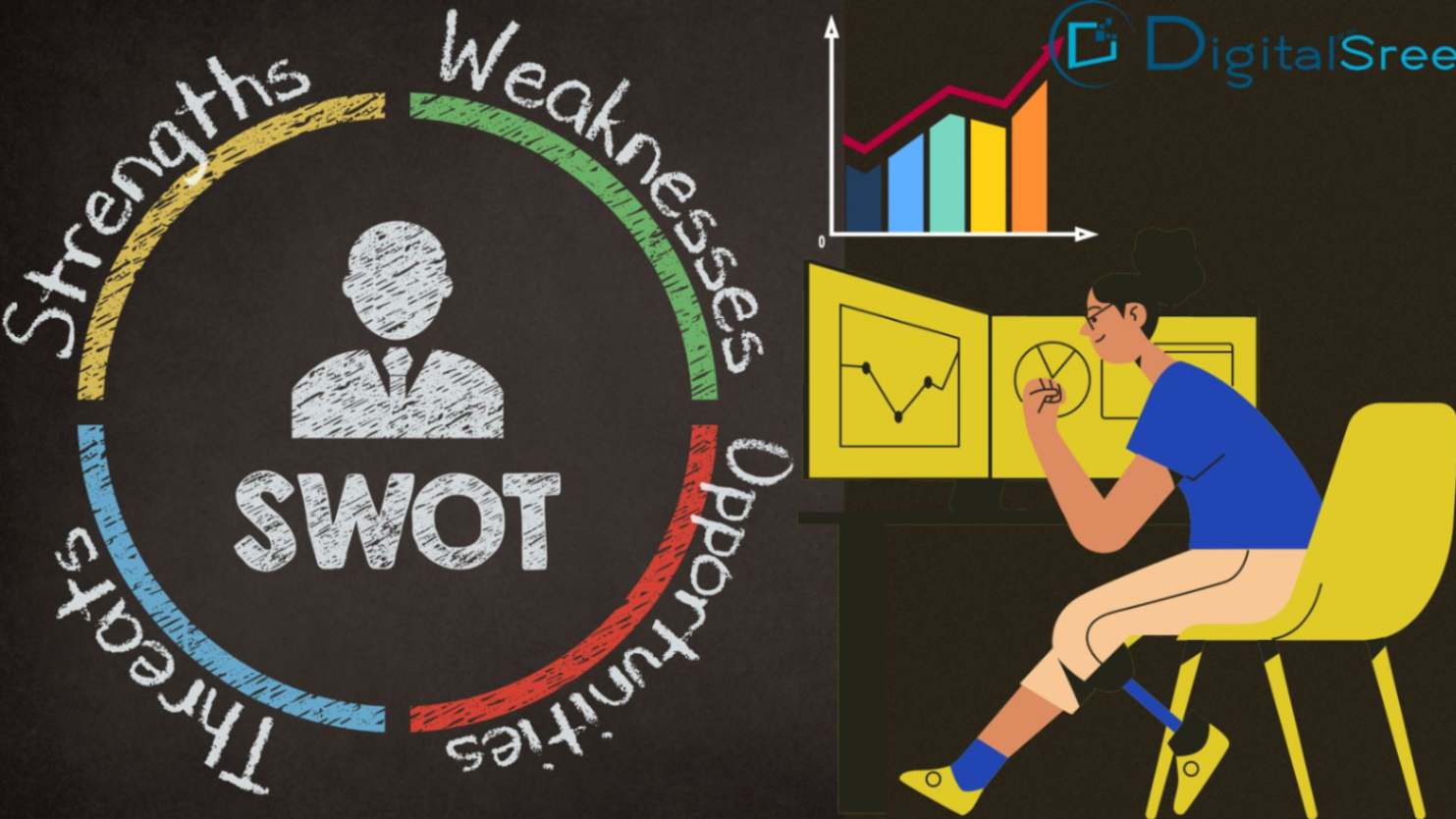How to Dominate the Market with SWOT Analysis of Digital Marketing
Today’s businesses must rely on digital advertising to stay competitive and reach their audience. To succeed, you must conduct a SWOT Analysis of digital marketing strategies. we will explore the importance of this in this blog. It helps companies stay on top of their competition.
Any form of marketing that uses electronic devices and the Internet is considered digital. Consumers have become dependent on this medium to access information and entertain themselves. Digital marketing allows marketers to adjust their strategies quickly based on instantaneous analysis and monitoring of campaign results.

Digital marketing refers to using various digital platforms for product or service promotion and sales development, engaging customers and driving sales. It involves multiple tactics, including social media, content and email marketing and search engine optimization (SEO). Since most consumers spend significant amounts of their time online, digital marketing provides businesses with an unprecedented opportunity to connect with target customers while building brand recognition – plus, it enables precise targeting, cost-effective campaigns and measurable outcomes, making digital an essential element in any successful marketing plan.
Marketing success requires self-awareness and an agile perspective, not simply knowing your strengths but understanding where your weaknesses may lie. SWOT Analysis in digital marketing acts as a beacon, showing strengths and weaknesses as well as external threats or opportunities that might impede its future growth – we will go over its significance here step-by-step so you have in-depth knowledge. There are plenty of digital marketing freelancer in Kerala to help you.
What is SWOT Analysis in Digital Marketing

Are You Seeking Ways To Strengthen Your digital marketing trends, then a SWOT Analysis in Digital Marketing can be an ideal way for businesses to maximize digital efforts and boost ROI – meaning optimizing campaigns to reach goals by understanding what works (and doesn’t). A SWOT Analysis also assists organizations with understanding where they stand within the market by devising strategies to take advantage of strengths while eliminating weaknesses and seizing opportunities while minimizing threats.
SWOT Analysis can be invaluable when creating marketing strategies and individual campaigns for businesses. It provides an in-depth framework to assess various aspects of their operations – internal strengths and weaknesses are revealed, providing invaluable insight into core competencies, while external threats/opportunities present growth/expansion opportunities. In contrast, threats pose risks/challenges to their goals of expansion or growth.
The SWOT Analysis of Digital Marketing is not just some marketing slang. Imagine checking the weather before going on a trip. It is essential to be aware of any threats or opportunities that may arise. You can also use SWOT to gain insights into our weaknesses and strengths within the team or strategy. Not only are you looking for problems, but also opportunities.
These insights, when implemented correctly, can dramatically increase your marketing success. Relying solely on instinct is not recommended even though seasoned marketers might think they know their agency well; platforms, algorithms and user behaviour frequently change, making the landscape unpredictable for marketing activities. Conducting a SWOT analysis allows businesses to identify critical areas for improvement as they optimize marketing efforts while staying ahead of competitors. As a digital marketing consultant in Kerala, I specialize in conducting SWOT analyses to identify critical areas for improvement, enabling businesses to optimize their marketing efforts and stay ahead of competitors
Components of SWOT Analysis

1. Strengths
A strong organization is characterized by its unique strengths: a well-developed brand, cutting-edge technology, an ideal location for business, an optimized website, effective SEO, extensive social media presence, opt-in emails, blog articles that are easy to find and low-competition keywords embedded, and employees who possess the necessary skills and knowledge.
Let’s now ask questions to determine your strengths. It’s essential to take into account different perspectives when assessing your strengths. These include those of employees, clients, stakeholders and competitors. These are some examples of questions that will reveal your strengths:
- What can the organization do better?
- What makes the company different from its competition?
- What’s your unique selling point?
- What products perform well?
- What are your resources that you don’t have?
Identifying your company’s positive aspects and using them as fuel for your desired goals is essential.
2. Weaknesses
Weaknesses are internal factors that can hinder your development and progress. Determining which aspects of your marketing plan are vulnerable during the SWOT Analysis is essential. This may be due to a lack of resources, an inability to access critical technology and skills, a poor business location, a weak social media profile, insufficient emails, substandard blog posts that are not keyword-targeted, or a product that fails to stand out from its competitors.
Identifying and addressing these weaknesses is essential to overcome obstacles and move forward. There are several questions to help you identify your weaknesses.
- What is your company lacking?
- Which products perform below expectations?
- How can you improve your sales funnel to overcome the obstacles?
- How often do reviews raise complaints or issues?
- What are the resources that your competitors possess and you do not?
Google Analytics and customer feedback on Google and Yelp platforms can provide valuable insight into weaknesses. These resources allow you to understand your company better and facilitate further improvement. You will have more opportunities to grow and improve your business the more you identify weaknesses.
3. Opportunities
These external influences are outside your direct control but significantly impact your business. They can help your company achieve its goals and foster growth. These opportunities can include shifting trends in marketing and consumer behaviour aligned with what you offer, positive customer reviews that boost your business’s reputation, highly engaging campaigns that engage your audience, increased engagement of your audience on social media, and taking advantage of newer technology.
Recognizing and leveraging these opportunities can help your business grow and open new doors for success. Asking yourself these questions can help you uncover new opportunities.
- What trends in the market could increase sales?
- What are some interesting trends in consumer behaviour that you might consider?
- Do you still have any untapped markets?
- Changes in technology or government policy could bring about some valuable changes.
- What shows and events could you attend to reach out to your market?
4. Threats
The term threat describes external negative factors beyond your control that can threaten your growth as a business. Businesses can protect their operations by proactively identifying potential threats. This can be an unstable economic climate, new competitors entering the market, changing consumer preferences and behaviour, industry regulation changes, technology advancements that could disrupt your business or other external factors that might negatively affect your operation.
Businesses can reduce the adverse effects of these threats by recognizing them and understanding their causes. Ask yourself these questions to identify possible threats:
- What advantages do your competitors possess?
- What are the new regulations?
- Which new technologies threaten your business today?
- What are the changing consumer habits?
- Are you experiencing cash flow problems or bad debts?
Blogs, newsletters, and competitive analyses conducted by experts in your industry can all provide invaluable tools for identifying threats. Staying abreast of industry technology developments and trends through reliable sources is critical in spotting threats while conducting a competitive analysis, which provides insight into any threats your competition poses – giving an early warning system against possible issues before they even arise. These resources help create awareness of potential dangers while taking proactive steps against any foreseeable threats they present.
Benefits by SWOT Analysis of Digital Marketing

SWOT analysis can be a potent technique for exploring an organization’s strengths, weaknesses and opportunities in greater depth. Every business possesses specific attributes that, if properly considered and examined closely enough, could become powerful drivers of its success when analyzed thoroughly. When applied to digital marketing environments like eCommerce businesses, conducting SWOT analyses can give a unique insight into industry positions and identify unique value propositions among competitors.
SWOT analysis can be a precious tool in evaluating product effectiveness and selecting effective marketing channels while pinpointing any weak points within campaigns or potential threats to company profits that might impact profitability, so as a company, you can proactively adjust and make necessary improvements based on strengths to offset weaknesses for maximum digital marketing success.
By conducting an in-depth SWOT Analysis with a digital marketing specialist in Kerala, your businesses can identify strengths, address weaknesses, seize growth opportunities, and mitigate threats to dominate the market effectively. Success in digital marketing demands strategic thinking and constant evaluation as trends change as consumer tastes do; harnessing SWOT Analysis of Digital Marketing allows marketers to formulate data-driven strategies that propel brands toward the forefront of industry competition.
Conclusion
Conducting a SWOT analysis of digital marketing efforts is integral for staying at the top of the marketing game. By identifying strengths, weaknesses, opportunities, and threats in relation to digital marketing efforts, you can build a strategic roadmap towards success – remember to leverage strengths, address weaknesses, seize opportunities and mitigate threats as part of an excellent digital marketing plan. In an ever-evolving digital landscape, strategies must stay competitive by adapting and speaking directly to the target audience to remain competitive; adding SWOT analysis as part of an overall digital marketing plan keeps businesses ahead of the competition while driving long-term growth for their companies.
As technology evolves, SWOT analysis in digital marketing may include increasingly sophisticated tools and techniques. Machine learning algorithms, predictive analytics and real-time data insights could improve accuracy and effectiveness, allowing businesses to confidently make data-driven decisions using SWOT analysis in digital marketing. Remember, the key to digital success lies in continuous learning adaptation innovation, so use SWOT analysis of digital marketing as an indispensable means of finding new opportunities, surmounting challenges and propelling your company towards long-term success in today’s digital marketplace. If you need a mentor for a digital marketing career, you can check out this digital marketing consultant in Kerala for your marketing journey.
